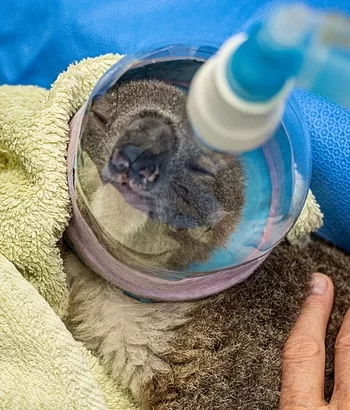On the 29th April, Cook set the anchor of H.M. Bark Endeavour in Kamay (the Dharawal nation name) which he gave an English name, Botany Bay.
As Cook and his men rowed ashore they were met with opposition from the First Nation residents. Two men from the Gweagal clan of the Dharawal nation confronted Cook and threw a stone at his boat.
One of the men was shot with a musket. Even before landing, Cook had shot one of the First Nations people.
“… one of them took up a stone and threw at us, which caused my firing a Second Musquet, load with small Shott; and altho’ some of the shott struck the man, yet it had no other effect than making him lay hold on a Target” (Note MA. Cook called a shield, “a target”)
“… all they seem’d to want was for us to be gone“
The landing site is now part of Kamay Botany Bay National Park, the dual name acknowledging a history of human settlement in the area dating back many thousands of years before the arrival of the Endeavour.
During their week in Kamay Botany Bay, Cook gave English names to Sutherland (after Seaman Forby Sutherland who died and was buried), Botany Bay (Cook had originally called it Sting Ray Bay and some charts refer to this name), and Port Jackson.
After spending a week exploring around Kamay / Botany Bay, the H.M. Bark Endeavour departed, giving the name Port Jackson to the entrance of Sydney Harbour as he passed, but not entering one of the largest and safest harbours in the world.
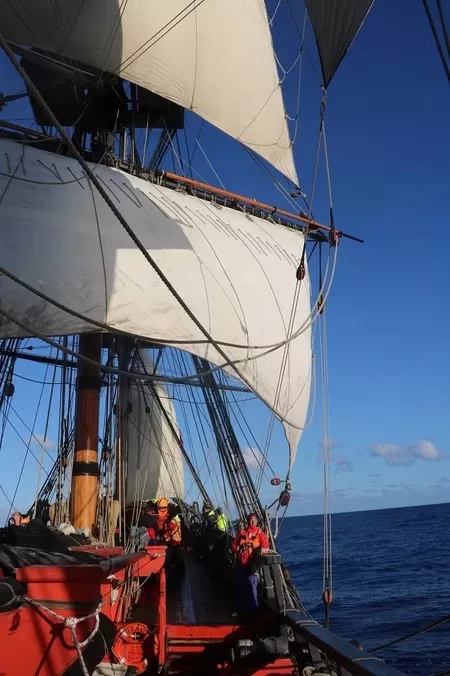

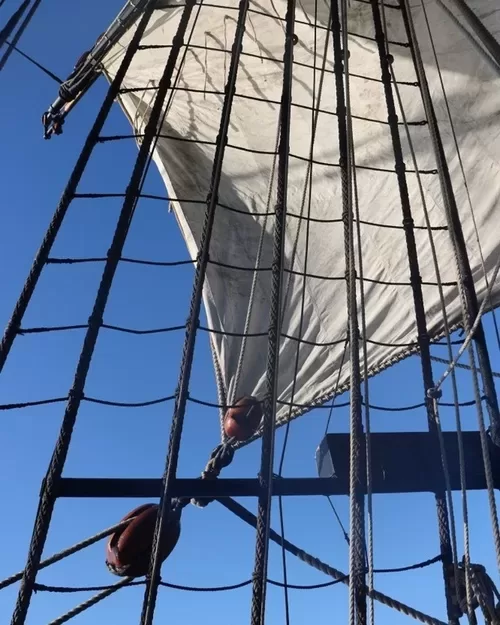





HMB Endeavour replica © 2019 Mark Anning photos. All Rights Reserved.
James Cook’s journal 29th April 1770 – “the shott struck the man”
[At Anchor, Botany Bay, New South Wales.]
Sunday, 29th. In the P.M. wind Southerly and Clear weather, with which we stood into the bay and Anchored under the South shore about 2 miles within the Entrance in 5 fathoms, the South point bearing South-East and the North point East.
Saw, as we came in, on both points of the bay, several of the Natives and a few hutts; Men, Women, and Children on the South Shore abreast of the Ship, to which place I went in the Boats in hopes of speaking with them, accompanied by Mr. Banks, Dr. Solander, and Tupia.
As we approached the Shore they all made off, except 2 Men, who seem’d resolved to oppose our landing.
As soon as I saw this I order’d the boats to lay upon their Oars, in order to speak to them; but this was to little purpose, for neither us nor Tupia could understand one word they said.
We then threw them some nails, beads, etc., a shore, which they took up, and seem’d not ill pleased with, in so much that I thought that they beckon’d to us to come ashore; but in this we were mistaken, for as soon as we put the boat in they again came to oppose us, upon which I fir’d a musquet between the 2, which had no other Effect than to make them retire back, where bundles of their darts lay, and one of them took up a stone and threw at us, which caused my firing a Second Musquet, load with small Shott; and altho’ some of the shott struck the man, yet it had no other effect than making him lay hold on a Target.
Immediately after this we landed, which we had no sooner done than they throw’d 2 darts at us; this obliged me to fire a third shott, soon after which they both made off, but not in such haste but what we might have taken one; but Mr. Banks being of Opinion that the darts were poisoned, made me cautious how I advanced into the Woods.
We found here a few small hutts made of the Bark of Trees, in one of which were 4 or 5 Small Children, with whom we left some strings of beads, etc.
A quantity of Darts lay about the Hutts; these we took away with us.
3 Canoes lay upon the beach, the worst I think I ever saw; they were about 12 or 14 feet long, made of one piece of the Bark of a Tree, drawn or tied up at each end, and the middle keept open by means of pieces of Stick by way of Thwarts.
After searching for fresh water without success, except a little in a Small hole dug in the Sand, we embarqued, and went over to the North point of the bay, where in coming in we saw several people; but when we landed now there were nobody to be seen.
We found here some fresh Water, which came trinkling down and stood in pools among the rocks; but as this was troublesome to come at I sent a party of men ashore in the morning to the place where we first landed to dig holes in the sand, by which means and a Small stream they found fresh Water sufficient to Water the Ship.
The String of Beads, etc., we had left with the Children last night were found laying in the Hutts this morning; probably the Natives were afraid to take them away.
After breakfast we sent some Empty Casks a shore and a party of Men to cut wood, and I went myself in the Pinnace to sound and explore the Bay, in the doing of which I saw some of the Natives; but they all fled at my Approach.
I landed in 2 places, one of which the people had but just left, as there were small fires and fresh Muscles broiling upon them; here likewise lay Vast heaps of the largest Oyster Shells I ever saw.


Cook’s landing at Botany Bay in 1770. Lithograph by unknown artist, first published in the Town and Country Journal New South Wales, 21 December 1872. Wikicommons.
James Cook’s journal 30th April 1770 – “all they seem’d to want was for us to be gone”
Monday, 30th. As Soon as the Wooders and Waterers were come on board to Dinner 10 or 12 of the Natives came to the watering place, and took away their Canoes that lay there, but did not offer to touch any one of our Casks that had been left ashore; and in the afternoon 16 or 18 of them came boldly up to within 100 yards of our people at the watering place, and there made a stand.
Mr. Hicks, who was the Officer ashore, did all in his power to intice them to him by offering them presents; but it was to no purpose, all they seem’d to want was for us to be gone.
After staying a Short time they went away. They were all Arm’d with Darts and wooden Swords; the darts have each 4 prongs, and pointed with fish bones.
Those we have seen seem to be intended more for striking fish than offensive Weapons; neither are they poisoned, as we at first thought.
After I had return’d from sounding the Bay I went over to a Cove on the North side of the Bay, where, in 3 or 4 Hauls with the Sean, we caught about 300 pounds weight of Fish, which I caused to be equally divided among the Ship’s Company.
In the A.M. I went in the Pinnace to sound and explore the North side of the bay, where I neither met with inhabitants or anything remarkable.
Mr. Green took the Sun’s Meridian Altitude a little within the South Entrance of the Bay, which gave the Latitude 34 degrees 0 minutes South.










HMB Endeavour replica © 2019 Mark Anning photos. All Rights Reserved.
James Cook’s journal 1st May 1770 – “Forby Sutherland, Seaman, departed this Life”
Tuesday, May 1st. Gentle breezes, Northerly. In the P.M. 10 of the Natives again visited the Watering place. I, being on board at this time, went immediately ashore, but before I got there they were going away.
I follow’d them alone and unarm’d some distance along shore, but they would not stop until they got farther off than I choose to trust myself.
These were armed in the same manner as those that came Yesterday.
In the evening I sent some hands to haul the Saine, but they caught but a very few fish. A little after sunrise I found the Variation to be 11 degrees 3 minutes East.
Last night Forby Sutherland, Seaman, departed this Life, and in the A.M. his body Was buried ashore at the watering place, which occasioned my calling the south point of this bay after his name.
This morning a party of us went ashore to some Hutts, not far from the Watering place, where some of the Natives are daily seen; here we left several articles, such as Cloth, Looking Glasses, Coombs, Beads, Nails, etc.; after this we made an Excursion into the Country, which we found diversified with Woods, Lawns, and Marshes.
The woods are free from underwood of every kind, and the trees are at such a distance from one another that the whole Country, or at least great part of it, might be Cultivated without being obliged to cut down a single tree.
We found the Soil every where, except in the Marshes, to be a light white sand, and produceth a quantity of good Grass, which grows in little Tufts about as big as one can hold in one’s hand, and pretty close to one another; in this manner the Surface of the Ground is Coated.
In the woods between the Trees Dr. Solander had a bare sight of a Small Animal something like a Rabbit, and we found the Dung of an Animal* which must feed upon Grass, and which, we judge, could not be less than a Deer; we also saw the Track of a Dog, or some such like Animal. (* This was the kangaroo.)
We met with some Hutts and places where the Natives had been, and at our first setting out one of them was seen; the others, I suppose, had fled upon our Approach.
I saw some Trees that had been cut down by the Natives with some sort of a Blunt instrument, and several Trees that were barqued, the bark of which had been cut by the same instrument; in many of the Trees, especially the Palms, were cut steps of about 3 or 4 feet asunder for the conveniency of Climbing them.
We found 2 Sorts of Gum, one sort of which is like Gum Dragon, and is the same, I suppose, Tasman took for Gum lac; it is extracted from the largest tree in the Woods.










HMB Endeavour replica © 2019 Mark Anning photos. All Rights Reserved.
Wednesday, 2nd. Between 3 and 4 in the P.M. we return’d out of the Country, and after Dinner went ashore to the watering place, where we had not been long before 17 or 18 of the Natives appeared in sight.
In the morning I had sent Mr. Gore, with a boat, up to the head of the Bay to drudge for Oysters; in his return to the Ship he and another person came by land, and met with these people, who followed him at the Distance of 10 or 20 Yards.
Whenever Mr. Gore made a stand and faced them they stood also, and notwithstanding they were all Arm’d, they never offer’d to Attack him; but after he had parted from them, and they were met by Dr. Monkhouse and one or 2 more, who, upon making a Sham retreat, they throw’d 3 darts after them, after which they began to retire.
Dr. Solander, I, and Tupia made all the haste we could after them, but could not, either by words or Actions, prevail upon them to come near us, Mr. Gore saw some up the Bay, who by signs invited him ashore, which he prudently declined.
In the A.M. had the wind in the South-East with rain, which prevented me from making an Excursion up the head of the bay as I intended.
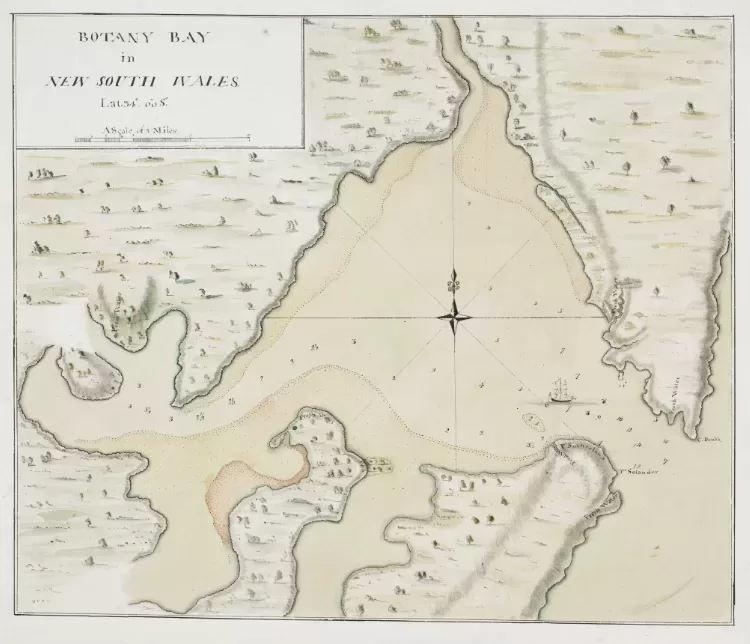

Lt James Cook map of Botany Bay
James Cook’s journal 3rd May 1770 – “fled before we came near them”
Thursday, 3rd. Winds at South-East, a Gentle breeze and fair weather. In the P.M. I made a little excursion along the Sea Coast to the Southward, accompanied by Mr. Banks and Dr. Solander.
At our first entering the woods we saw 3 of the Natives, who made off as soon as they saw us; more of them were seen by others of our people, who likewise made off as soon as they found they were discover’d.
In the A.M. I went in the Pinnace to the head of the bay, accompanied by Drs. Solander and Monkhouse, in order to Examine the Country, and to try to form some Connections with the Natives.
In our way thither we met with 10 or 12 of them fishing, each in a Small Canoe, who retir’d into Shoald water upon our approach.
Others again we saw at the first place we landed at, who took to their Canoes, and fled before we came near them; after this we took Water, and went almost to the head of the inlet, were we landed and Travel’d some distance in land.
We found the face of the Country much the same as I have before described, but the land much richer for instead of sand I found in many places a deep black soil, which we thought was Capable of producing any kind of grain.
At present it produceth, besides Timber, as fine Meadow as ever was seen; however, we found it not all like this, some few places were very rocky, but this, I believe, to be uncommon.
The stone is sandy, and very proper for building, etc. After we had sufficiently examin’d this part we return’d to the Boat, and seeing some Smoke and Canoes at another part we went thither, in hopes of meeting with the people, but they made off as we approached.
There were 6 Canoes and 6 small fires near the Shore, and Muscles roasting upon them, and a few Oysters laying near; from this we conjectured that there had been just 6 people, who had been out each in his Canoe picking up the Shell fish, and come a Shore to eat them, where each had made his fire to dress them by.
We tasted of their Cheer, and left them in return Strings of beads, etc.
The day being now far spent, we set out on our return to the Ship.










HMB Endeavour replica © 2019 Mark Anning photos. All Rights Reserved.
James Cook’s journal 4th May 1770 – “he had a dart thrown at him”
Friday, 4th. Winds northerly, serene weather. Upon my return to the Ship in the evening I found that none of the Natives had Appear’d near the Watering place, but about 20 of them had been fishing in their Canoes at no great distance from us.
In the A.M., as the Wind would not permit us to sail, I sent out some parties into the Country to try to form some Connections with the Natives.
One of the Midshipmen met with a very old man and Woman and 2 Small Children; they were Close to the Water side, where several more were in their Canoes gathering of Shell fish, and he, being alone, was afraid to make any stay with the 2 old People least he should be discovr’d by those in the Canoes.
He gave them a bird he had Shott, which they would not Touch; neither did they speak one word, but seem’d to be much frightned.
They were quite Naked; even the Woman had nothing to cover her nudities.
Dr. Monkhouse and another Man being in the Woods, not far from the watering place, discover’d 6 more of the Natives, who at first seem’d to wait his coming; but as he was going up to them he had a dart thrown at him out of a Tree, which narrowly escaped him.
As soon as the fellow had thrown the dart he descended the Tree and made off, and with him all the rest, and these were all that were met with in the Course of this day.








A plan of Sting-ray Bay on the Et. Coast of New Holland / R. Pickersgill.
James Cook’s journal 5th May 1770 – fishing for sting rays
Saturday, 5th. In the P.M. I went with a party of Men over to the North Shore, and while some hands were hauling the Sean, a party of us made an Excursion of 3 or 4 Miles into the Country, or rather along the Sea Coast.
We met with nothing remarkable; great part of the Country for some distance inland from the Sea Coast is mostly a barren heath, diversified with Marshes and Morasses.
Upon our return to the Boat we found they had caught a great number of small fish, which the sailors call leather Jackets on account of their having a very thick skin; they are known in the West Indies.
I had sent the Yawl in the morning to fish for Sting rays, who returned in the Evening with upwards of four hundred weight; one single one weigh’d 240 pounds Exclusive of the entrails.
In the A.M., as the wind Continued Northerly, I sent the Yawl again a fishing, and I went with a party of Men into the Country, but met with nothing extraordinary.
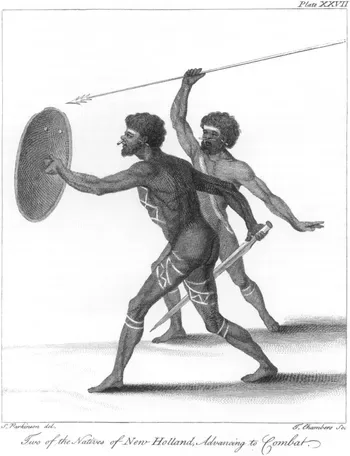

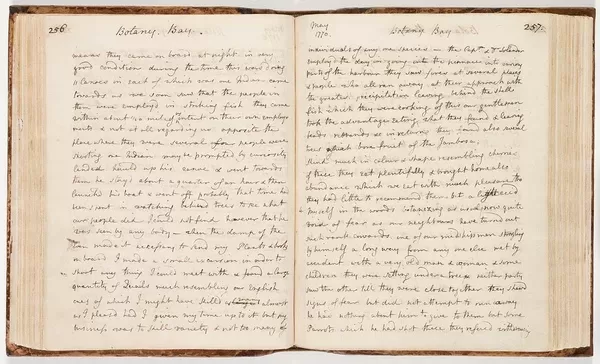

Left: Thomas Chambers, engraving possibly after Sydney Parkinson, ‘Two of the Natives of New Holland, Advancing to Combat’ to leave their ‘Country in the pure state of Nature’. British Library, public domain.
Right: Cook’s journal, Mitchell Library, NSW
James Cook’s journal 6th May 1770 – “giving it the Name of Botany Bay”
Sunday, 6th. In the evening the Yawl return’d from fishing, having Caught 2 Sting rays weighing near 600 pounds. The great quantity of plants Mr. Banks and Dr. Solander found in this place occasioned my giving it the Name of Botany Bay. (* 1)
It is situated in the Latitude of 34 degrees 0 minutes South, Longitude 208 degrees 37 minutes West.
It is capacious, safe, and Commodious; it may be known by the land on the Sea Coast, which is of a pretty even and moderate height, Rather higher than it is inland, with steep rocky Clifts next the Sea, and looks like a long Island lying close under the Shore.
The Entrance of the Bay lies about the Middle of this land. In coming from the Southward it is discover’d before you are abreast of it, which you cannot do in coming from the Northward; the entrance is little more than a Quarter of a Mile broad, and lies in West-North-West.
To sail into it keep the South shore on board until within a small bare Island, which lies close under the North Shore.
Being within that Island the deepest of Water is on that side, 7, 6 and 5 fathoms a good way up; there is Shoald Water a good way off from the South Shore — from the inner South Point quite to the head of the harbour; but over towards the North and North-West Shore is a Channell of 12 or 14 feet at low Water, 3 or 4 Leagues up, to a place where there is 3 or 4 fathoms; but there I found very little fresh Water.
We Anchor’d near the South Shore about a Mile within the Entrance for the Conveniency of Sailing with a Southerly wind and the getting of Fresh Water; but I afterwards found a very fine stream of fresh Water on the North shore in the first sandy Cove within the Island, before which the Ship might lay almost land locked, and wood for fuel may be got everywhere.
Although wood is here in great plenty, yet there is very little Variety; the bigest trees are as large or larger than our Oaks in England, and grows a good deal like them, and Yields a reddish Gum; the wood itself is heavy, hard, and black like Lignum Vitae.
Another sort that grows tall and Strait something like Pines—the wood of this is hard and Ponderous, and something of the Nature of America live Oak.
These 2 are all the Timber trees I met with; there are a few sorts of Shrubs and several Palm Trees and Mangroves about the Head of the Harbour.
The Country is woody, low, and flat as far in as we could see, and I believe that the Soil is in general sandy.
In the Wood are a variety of very beautiful birds, such as Cocatoos, Lorryquets, Parrots, etc., and crows Exactly like those we have in England.
Water fowl is no less plenty about the head of the Harbour, where there is large flats of sand and Mud, on which they seek their food; the most of these were unknown to us, one sort especially, which was black and white, and as large as a Goose, but most like a Pelican.* (* Most probably the Black and White or Semipalmated Goose, now exterminated in these parts.)
On the sand and Mud banks are Oysters, Muscles, Cockles, etc., which I believe are the Chief support of the inhabitants, who go into Shoald Water with their little Canoes and peck them out of the sand and Mud with their hands, and sometimes roast and Eat them in the Canoe, having often a fire for that purpose, as I suppose, for I know no other it can be for.
The Natives do not appear to be numerous, neither do they seem to live in large bodies, but dispers’d in small parties along by the Water side.
Those I saw were about as tall as Europeans, of a very dark brown Colour, but not black, nor had they woolly, frizled hair, but black and lank like ours.
No sort of Cloathing or Ornaments were ever seen by any of us upon any one of them, or in or about any of their Hutts; from which I conclude that they never wear any.
Some that we saw had their faces and bodies painted with a sort of White Paint or Pigment.
Altho’ I have said that shell fish is their Chief support, yet they catch other sorts of fish, some of which we found roasting on the fire the first time we landed; some of these they strike with Gigs,* (* A fishing implement like a trident.) and others they catch with hook and line; we have seen them strike fish with gigs, and hooks and lines are found in their Hutts.
Sting rays, I believe, they do not eat, because I never saw the least remains of one near any of their Hutts or fire places. However, we could know but very little of their Customs, as we never were able to form any Connections with them; they had not so much as touch’d the things we had left in their Hutts on purpose for them to take away.
During our stay in this Harbour I caused the English Colours to be display’d ashore every day, and an inscription to be cut out upon one of the Trees near the Watering place, setting forth the Ship’s Name, Date, etc.
[Off Port Jackson, New South Wales.]
Having seen everything this place afforded, we, at daylight in the morning, weigh’d with a light breeze at North-West, and put to Sea, and the wind soon after coming to the Southward we steer’d along shore North-North-East, and at Noon we were by observation in the Latitude of 33 degrees 50 minutes South, about 2 or 3 Miles from the Land, and abreast of a Bay, wherein there appear’d to be safe Anchorage, which I called Port Jackson. (* 2.)
It lies 3 leagues to the Northward of Botany Bay. I had almost forgot to mention that it is high water in this Bay at the full and change of the Moon about 8 o’Clock, and rises and falls upon a Perpendicular about 4 or 5 feet.
°°°
(* 1. The Bay was at first called Stingray Bay. The plan of it at the Admiralty is called by this name, and none of the logs know Botany Bay. It seems probable that Cook finally settled on the name after the ship left, and when Banks had had time to examine his collections. A monument was erected in 1870 near the spot, on the southern side, where Cook first landed. Botany Bay was intended to be the site where the first settlement of convicts should be made, but on the arrival of Captain Phillip, on January 18th, 1788, he found it so unsuited for the number of his colony that he started in a boat to examine Broken Bay. On his way he went into Port Jackson, and immediately decided on settling there. On the 25th and 26th the ships went round, and Sydney was founded. – Captain Wharton)
(* 2. Cook having completed his water at Botany Bay, and having many hundreds of miles of coast before him, did not examine Port Jackson, the magnificent harbour in which Sydney, the capital of New South Wales, now lies. His chart gives the shape of what he could see very accurately, but the main arm of the harbour is hidden from the sea. He named the bay after Mr. (afterwards Sir George) Jackson, one of the Secretaries of the Admiralty. This fact is recorded on a tablet in the Bishop Stortford Church to the memory of Sir George Duckett, which name Sir George had assumed in later years. This interesting evidence was brought to light by Sir Alfred Stephen, Lieutenant-Governor of New South Wales, and puts an end to the legend which was long current, that Port Jackson was named after a sailor who first saw it. There was, moreover, no person of the name of Jackson on board. – Captain Wharton)
°°°°
Four Australian Aboriginal spears – cared for by Cambridge’s Museum of Archaeology and Anthropology – are to be repatriated after Trinity College agreed to permanently return them to the country..
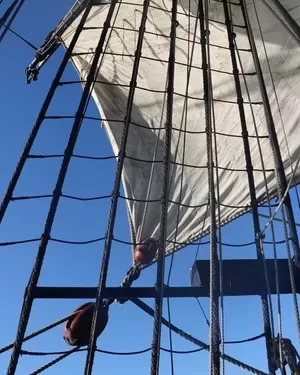

See also: List of Persons Who Left England in HMB Endeavour, 26th August, 1768
1. Captain Cook’s ship Endeavour confirmed found in Newport Harbour, USA
2. Secret Orders to Captain James Cook on H.M. Bark ENDEAVOUR
3. Captain Cook’s Journal 1-18 Apr.1770: Passage from New Zealand to New Holland
4. James Cook journal: 20th – 28th April, 1770 on HMB Endeavour




